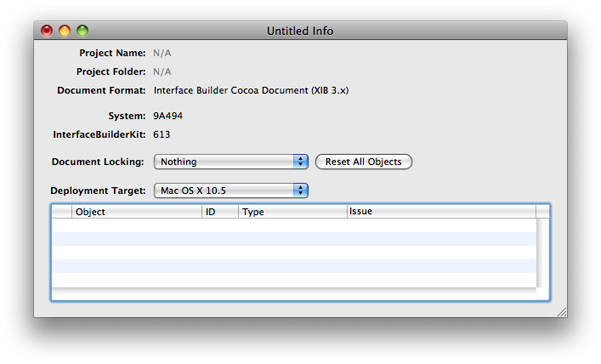Testing and Validation
Interface Builder provides tools to help you validate the contents of your documents against the platform on which you plan to use them. In addition to testing the behavior of your interface in the simulator, you can also verify that the operating system on which you plan to run your software supports all of your nib file objects. Different versions of an operating system may support different objects or different attributes for those objects. If your nib files contain objects that are not available on the current platform, your program may crash.
The following sections show you how to use Interface Builder to test your nib files.
In this section:
Setting the Nib File Version
Checking for Errors and Warnings
Simulating Your Interface
Setting the Nib File Version
The default toolbar in a nib document window contains an information button that you can use to get information about the nib file. When clicked, this button displays the nib information window. (You can also open the window by choosing Window > Document Info.) Among other things, this window displays the following pieces of information:
The associated Xcode project information
The intended deployment platform for the nib file
The lock attributes for the nib file; see “Locking Down Your Nib File”
Any design errors, warnings, and notes
Figure 8-1 shows an information window with a few design time issues. Double-clicking an item in this table selects the item and brings it to the foreground.
For each nib file in your project, you should set the deployment target value to match the deployment target of the Xcode target that uses the nib file. Interface Builder uses deployment targets to identify potential problems with your nib file. For example, if your deployment target is set to Mac OS X v10.3 but a window includes a control that was introduced in Mac OS X v10.5, Interface Builder reports the inclusion of the control as an error. Correcting the errors listed in this window ensures that the nib can be loaded successfully on the target platform.
You must remove errors before saving your nib file and should try to remove warnings as well. Although you can change the severity of different types of design issues from the Interface Builder preferences window, you should do so only when you know that it will not affect the ability to load and use your nib file.
Checking for Errors and Warnings
Prior to saving your nib file, it is a good idea to set the deployment target and see whether the file generates any errors or warnings. Although Interface Builder Does not prevent you from saving a nib that contains errors and warnings, those conditions may cause problems when you load the nib into your application. For example, if your nib contains controls that were introduced in Mac OS X v10.4, your nib-loading code would not be able to load the nib on a computer running Mac OS X v10.3.
To view the errors and warnings in your nib file, you use the information window (see Figure 8-1). From this window, you can set the intended deployment target for the nib file and see whether it contains an errors or warnings that might prevent the nib file from loading. Double-clicking the entries in the table takes you directly to the object that is causing the problem.
Simulating Your Interface
Although Interface Builder displays your views almost exactly as they appear in your application, it is primarily intended for designing interfaces and therefore adds adornments and other visual cues to help you manipulate your views and controls. The simulator presents your views exactly as they would appear when loaded by your application. In addition, the simulator provides the following behaviors:
The resizing rules of your window work exactly as they would at runtime.
Cocoa bindings are active. Any views bound to user defaults or other views display the appropriate data.
Actions that occur relative to other views in the window can be exercised.
To enter simulation mode for a window, select the window and choose File > Simulate Interface. To exit simulation mode, choose Quit from the simulator application menu or press Command-Q. Upon quitting the simulator, you are returned to Interface Builder.
© 2008 Apple Inc. All Rights Reserved. (Last updated: 2008-11-19)
